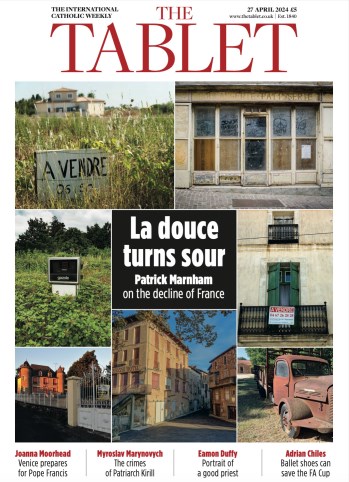Images of Heaven, Hell and Purgatory loom large in popular culture, but less so in Scripture. The human imagination bridges this gap and creates music, films, games and novels that help us to make sense of our lives
ccording to several polls taken in the past few years, belief in God and belief in life after death do not necessarily go together. In 2012, roughly half of Britons surveyed said that they believed in an afterlife even though only about a third of them said they believed in God. A survey this year found that a quarter of agnostics think that death is not the end, while a third of religious believers rejected the idea.
So, many non-believers have a strong sense that something awaits them when we die and that that something is probably Heaven.
Given that the majority are not relying on holy writ to form their beliefs, where do those beliefs come from? Well, in large part, they come from our art and culture, where death, the “undead”, Heaven, Hell and Purgatory continue to be depicted with regularity. These stories remain popular for us because they serve as master narratives that help us both to explain our present lives and to feel some sense of comfort that there is justice and mercy in a universe that often doesn’t demonstrate either. We are drawn to stories of Heaven, Hell and Purgatory – even those of us who don’t actually believe in them – because they help us make meaning out of some difficult questions.
It’s a mistake to think that the Bible has ever been the primary source of our information on the afterlife. The New Testament scholar Tom Wright argues that there is little in either the Hebrew or Christian testaments about “going to Heaven when you die”, and he is one of many who suggest that human imagination has been largely responsible for painting the pictures suggesting what happens to us in the world to come. Dante, medieval art and other forms of culture – and not the scant references to the afterlife, demons and angels in the Bible, Wright says in his book Surprised by Hope – have been much more influential in our beliefs about the afterlife than Scripture, and that influence seems to be borne out by the ways we continue to believe in an afterlife, even those who don’t claim any sort of belief in the divine.
One doesn’t need to do much more than open one’s eyes to see that angels and demons, zombies and vampires, Heaven, Hell and Purgatory pervade our literature and culture. Whether these stories are employing elements of our sacred stories or retelling them, they are serving that important function of helping us cope with the unknown territory after this life. In “The Satan Pit”, a Doctor Who episode featuring David Tennant, the Doctor confronts the Beast, a supernatural creature imprisoned in the pit after losing a cosmic conflict against good – and implied to be the archetype for our stories of Satan. It’s a story that helps us understand that evil has been a part of our cosmos for a long time – and that it will be punished by cosmic good. In the final Harry Potter book and film, Harry talks with Dumbledore in a ghostly King’s Cross Station and together they decide whether he will return to earth or get on a train and go “on” to whatever thing awaits such noble souls as his. It’s a story that tells us that death is not the end, and that in some intermediate stage, our fate will be decided.
In the TV series Lost, after denying viewers’ claims that the desert island home of the characters was Purgatory, the show’s writers intentionally created a “Sideways World” – an alternate reality that actually did function as Purgatory – in the final season of the show. The Sideways World was a place of purgation, growth and restoration, a place where the horrors of the island fell away and the joys were rekindled. In this, we are hearing a story not of fear, but of hope.
As Carol Zaleski, who teaches world religions at Smith College, Massachusetts, told me: “I believe that the fires of Purgatory are lit by divine love, and that their purpose is to purify and perfect, not to harm or destroy. Purgatory will make us fit for Heaven; therefore it is a merciful doctrine and a ground for hope.” Lost reminds us that our final hope is to be found.
In all these stories in our literature and culture – and in very many more – Heaven, Hell, Purgatory and their various inhabitants continue to flourish. In fact, music, movies, art, video and computer games, comics, stories of all kinds either present versions of the afterlife, or use the spiritual teachings of Heaven, Hell and Purgatory as a functional story pattern. Do a search for songs with “Paradise” in the title, or check out the 206 million results you get if you Google “Hell” and “movie”. Take note of the fact that in the United Kingdom, the United States and almost every country where it airs, The Walking Dead’s animated corpses shamble to the top of the TV ratings chart. The afterlife is everywhere in our culture, except in some modern Christian thinking. While some Christians may put talk about Heaven and Hell at the forefront of their beliefs, liberal Western Christians find it difficult to talk about – or even to truly believe in – such places.
The afterlife was not always marginalised, of course, nor was it largely the property of one group of believers. And it would be a mistake to say that it is completely missing from Christians’ lives today. Even if we do not talk theologically about the afterlife, many of us do recite daily in the Apostles’ Creed that we believe in the life eternal, or in the Nicene Creed that we believe Jesus ascended into Heaven, from which he will return to judge the living and the dead and then to rule over a kingdom that will have no end. I know that I find myself getting a lump in my throat when I recite these words – even though I don’t know how, exactly, that kingdom is going to look.
The lack of conscious thought we give the afterlife may come from the fact that many of us have become uncomfortable with any faith expression that seems only centred on the next world, or to be employing a concept of the afterlife largely to shape the behaviour we encounter in this life. Certainly some of us, too, are seized by the belief that talking about Heaven, Hell or Purgatory will make us seem more than faintly ridiculous among our friends and fellows in 2015.
But the afterlife and its denizens have not always embarrassed us. For the first 1,000 years or so of Christian history, for example, many of the Church Fathers chose angels as a particular subject of interest. Ambrose of Milan and Augustine of Hippo had an interest in angelology; Augustine wrote extensively about angels – and the fallen angels – in works as central to Christian thought as The City of God. Thomas Aquinas references angels almost 3,000 times in his Summa Theologica, including a substantial “Treatise on the Angels”. Some commentators complain that Aquinas’ focus on angels actually threatens to become a distraction from his writing about God. And Dante, of course, under the influence of Pseudo-Dionysius the Areopagite’s fifth- or sixth-century work On the Celestial Hierarchy, performs a supreme work of theological and artistic imagination in designing and populating Heaven, Hell and Purgatory, an imaginative rendering that continues to influence the way we think about the afterlife to our very present.
It may be difficult to take seriously some of the visions of Heaven that preachers, writers and artists have conjured up. The stereotypical fluffy-cloud Heaven, where the redeemed sport wings and pluck harps, is largely out of fashion now, perhaps for good reason. It seems ridiculous to think that God couldn’t come up with anything better. The horned Devil lording it over a flaming Hell seems like – and is – something out of cartoons. And while Purgatory of course remains official Catholic dogma (the Vatican recently suggested that those following Pope Francis on Twitter might receive indulgences), it becomes hard to believe in the in-between place if you don’t take seriously either of the polar opposites.
Nonetheless, stories of Heaven, Hell and Purgatory are all around us – and we can use them as a way to lay a trail of bread crumbs back to the tradition. People love these stories, and use these stories, because they are at the heart of our human concerns. What happens to us when we die, whether or not the universe is fair or just, and whether there is a design or a designer – these are universal questions. And these stories of the afterlife, wherever they come from, are a part of our quest to answer them.
Greg Garrett is 2013 Centennial Professor at Baylor University in Texas and the author of Entertaining Judgment: the afterlife in popular imagination.





 Loading ...
Loading ...
What do you think?
You can post as a subscriber user...
User Comments (1)
In the Western world where no one any longer knows what metaphysics even is, philosophy is treated as logic and sociology, politics as economics, and religion as myth and superstition. In order, therefore, not to regress to early Hebrew vagueness about what life after death actually is, the Church has urgently to revitalise its ‘perennial philosophy’, to show how, after death, when we rise from the dead, we will be “as the angels in Heaven are”.